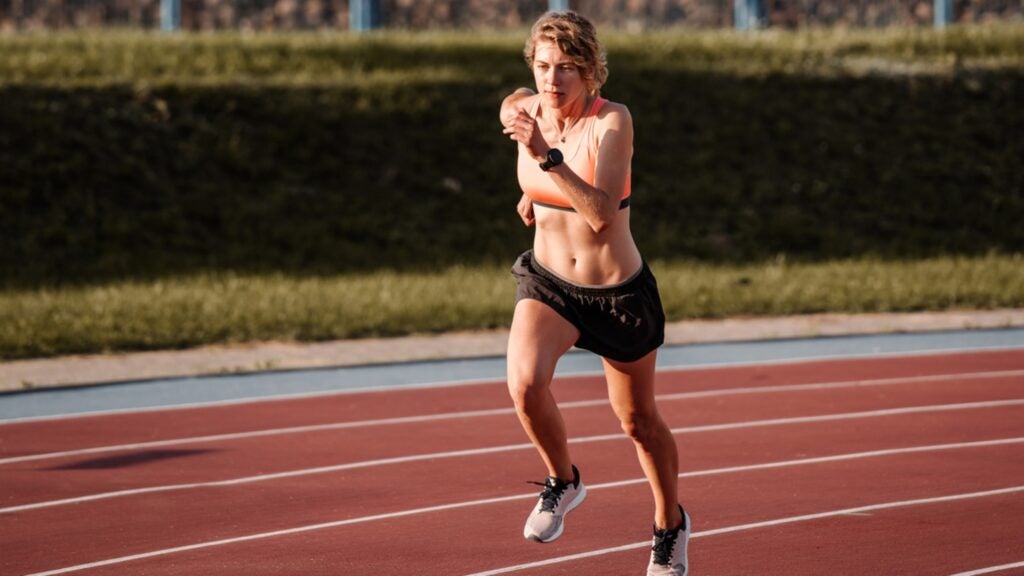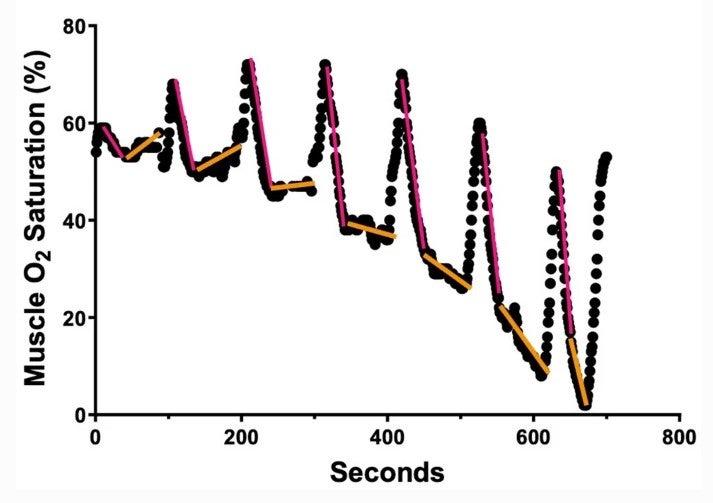
One of many notable subjects that popped up on the American School of Sports activities Drugs convention earlier this month was muscle oxygen monitoring. (For extra from the ACSM convention, see my earlier updates on supershoes and sports activities psychology.) I wrote an article final yr on muscle oxygen sensors, questioning if they might end up be “the subsequent nice health wearable.” They’re not there but, however the brand new analysis at ACSM and elsewhere is trying to construct a case.
Fast background: muscle oxygen sensors for athletes are matchbox-sized gadgets that you just stick onto a related muscle. For runners or cyclists, that’s someplace in your legs. The gadget makes use of near-infrared spectroscopy to evaluate what fraction of the hemoglobin and myoglobin molecules within the tissue are carrying oxygen. If the quantity is growing, it implies that your coronary heart and lungs are delivering extra oxygen than the muscle is utilizing. If it’s lowering, it means demand exceeds provide and exhaustion awaits. The principle participant within the muscle oxygen area is Moxy, whose gadgets at present promote for $879.
The brand new outcomes at ACSM come from a gaggle led by Brett Kirby at Nike, working with different key members of Nike’s Breaking2 group: former colleague Brad Wilkins of the College of Oregon, plus Ida Clark, Anni Vanhatalo, and Andrew Jones of the College of Exeter. And the query it addresses may be very related to the pursuit of a two-hour marathon: is muscle oxygen nonetheless a helpful metric after you’ve already been exercising for 2 hours?
Again in 2021, Kirby and colleagues revealed knowledge exhibiting that muscle oxygen measurements can reveal once you’ve crossed a “vital metabolic fee,” and the way a lot time you have got left earlier than exhaustion when you’ve crossed it. The brand new knowledge compares quadriceps muscle oxygen knowledge taken throughout all-out three-minute sprints once you’re contemporary to related knowledge taken after two hours of reasonably arduous biking. Absolutely the numbers are completely different: you truly keep increased muscle oxygen ranges once you’re exhausted, presumably as a result of different sources of fatigue forestall you from digging as deep through the dash. However the muscle oxygen developments—how shortly it’s growing or lowering—nonetheless precisely predict once you’ll surrender. That’s an enormous step towards demonstrating that muscle oxygen may be helpful within the area, not simply the lab.
One other new research, this one revealed earlier this month within the European Journal of Utilized Physiology, makes the case that muscle oxygen sensors would possibly be capable of exchange cumbersome lactate testing in some contexts. It was led by Philip Batterson of Oregon State College (and likewise contains Kirby and others as co-authors). Lactate testing has been utilized in train science labs for many years, and lately moveable lactate screens requiring a drop of blood from a finger or ear prick have grown in recognition. After I wrote in regards to the “Norwegian Technique” of double threshold coaching, which depends closely on lactate testing to take care of the suitable depth, the principle query I received was the way to implement this form of coaching with out the trouble of repeated lactate testing. I didn’t have an important reply.
The brand new research basically administered a normal lactate testing protocol, alternating three minutes of operating with 30 seconds of relaxation (throughout which the blood was collected for lactate testing), with the depth of the operating phases ramping up till the themes reached exhaustion. This form of check produces a attribute lactate curve, from which you’ll be able to calculate two distinct thresholds: LT1, the place lactate first begins growing from its resting values, and LT2, typically referred to as lactate turnpoint, the place it will increase extra sharply and can by no means stabilize even in the event you maintain the tempo the identical. (For extra on the admittedly complicated terminology of thresholds, see this deep dive.)
Throughout the lactate check, the themes additionally wore Moxy screens on their quadriceps (and elsewhere, which we’ll ignore). The important thing discovering is that muscle oxygen produced a curve similar to the lactate curve, with two identifiable thresholds that have been statistically indistinguishable from the lactate thresholds. This implies {that a} muscle oxygen monitor, which requires no bloodletting or inconvenient breaks in your exercise, would possibly be capable of stand in for lactate testing.
There are some caveats. Most notably, it’s not the precise worth of muscle oxygen that offers you the knowledge you want. As an alternative, it’s the pattern: how shortly it’s growing or lowering. And there’s one other catch: everytime you relaxation, muscle oxygen will increase sharply. Then once you begin exercising once more, it decreases sharply earlier than settling right down to a extra regular slope. So the evaluation within the new research (and former research) ignores all readings through the first 60 seconds of every train stage, then calculates the slope from the next knowledge.
Right here’s some pattern knowledge from one of many incremental assessments. The dots present muscle oxygen readings. Each time the curve is growing sharply, these are the 30-second relaxation durations. When it’s lowering sharply (crimson traces), that’s the info that’s omitted. The “actual” slopes are proven with orange traces:

The important thing factor to note right here is that on the decrease intensities early within the check (on the left), the orange slopes level upward. Which means oxygen provide is bigger than demand within the muscle. On the increased intensities later within the check (on the suitable), the slopes are progressively steeper downward. Which means demand exceeds provide. The vital metabolic threshold, the place the orange line can be horizontal, can be at a tempo someplace between the third and fourth phases. Plotting the slopes of the orange traces on a separate graph provides you the equal of a lactate curve, and will allow you to make use of real-time muscle oxygen readings to remain at a desired depth degree in the event you resolve to attempt coaching Norwegian-style.
There’s nonetheless a variety of math occurring right here. Once I spoke to researchers on this area final yr, the overall sentiment was that muscle oxygen supplied helpful insights, however that the problem can be making these insights accessible (to not point out inexpensive) to the common shopper. I feel that evaluation stays true for now, however you can begin to see glimmers of what a hypothetical consumer-friendly muscle oxygen sensor would possibly seem like sooner or later—and, extra importantly, why you may want one.
For extra Sweat Science, be a part of me on Twitter and Fb, join the e-mail e-newsletter, and take a look at my guide Endure: Thoughts, Physique, and the Curiously Elastic Limits of Human Efficiency.
Supply Hyperlink : fkmie.com
